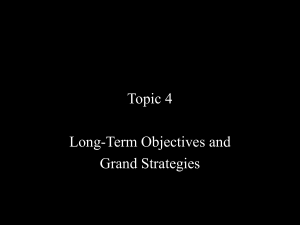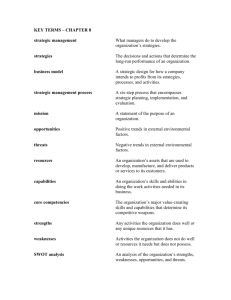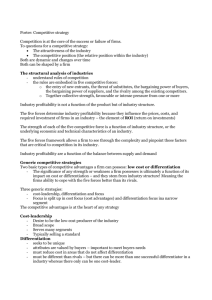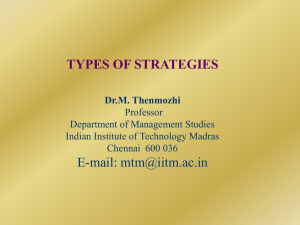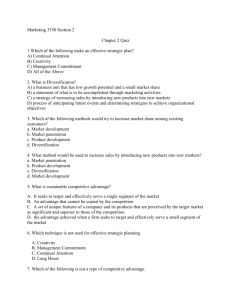Here are PPT Slides that define a number of helpful STRATEGIES
advertisement
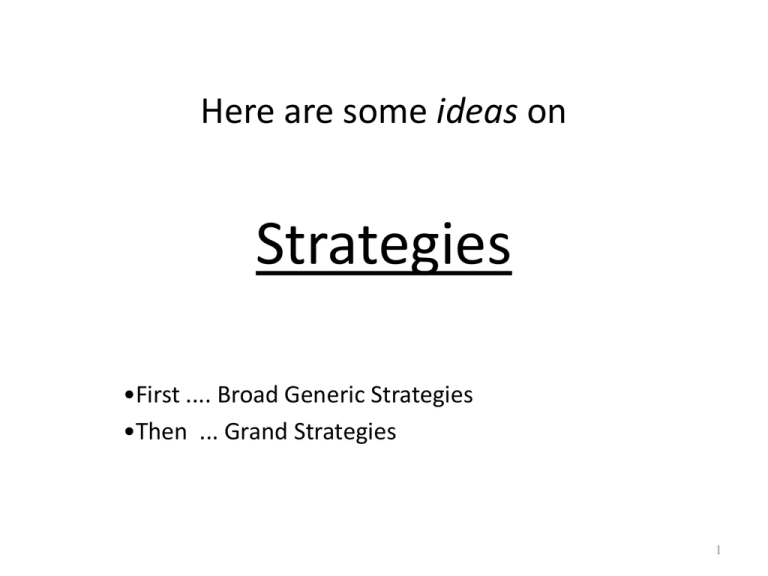
Here are some ideas on Strategies •First .... Broad Generic Strategies •Then ... Grand Strategies 1 Generic Strategies Low-cost Leadership Differentiation Focus 2 Requirements for Generic Competitive Strategies Generic Strategy Overall Cost Leadership Commonly Required Skills and Resources •Sustained capital investment and access to capital •Process engineering skills •Intense supervision of labor •Products designed for ease in manufacture •Low-cost distribution system Common Organizational Requirements •Tight cost control •Frequent, detailed control reports •Structured organization and responsibilities •Incentives based on meeting strict quantitative targets 3 Requirements for Generic Competitive Strategies ... Cont. Generic Strategy Commonly Required Skills and resources Common Organizational Requirements Differentiation •Product engineering •Creative flare •Strong capability in basic research •Corporate reputation for quality or technological leadership •Unique combination of skills •Strong cooperation from channels •Strong marketing abilities •Strong coordination among functions in R&D, product development, and marketing •Subjective measurement and incentives instead of quantitative measures •Amenities to attract highly skilled labor, scientists, or creative people Focus Combination of above policies directed at the particular strategic target Combination of above policies directed at the particular 4 strategic target Risks of the Generic Strategies Risks of Cost Leadership Risks of Differentiation Risks of Focus Cost leadership is not sustained •Competitors imitate •Technology changes •Other bases for cost leadership erode Proximity in differentiation is lost Cost focusers achieve even lower cost in segments Differentiation is not sustained •Competitors imitate •Bases for differentiation become less important to buyers Cost proximity is lost Differentiation focusers achieve greater differentiation in segments Focus strategy is imitated Target segment becomes unattractive •Structure erodes •Demand disappears Broadly target competitors overwhelm segments •Segment’s differences from others narrow •Advantages of broad line increase 5 Out of the Box????? Types of Grand Strategies • Concentrated growth • Market development • Product development • Innovation • Horizontal integration • Vertical integration • Conglomerate diversification • Turnaround • Divestiture • Liquidation • Bankruptcy • Joint ventures • Strategic alliances • Concentric diversification 6 Characteristics of a Concentrated Growth Strategy • Involves focusing resources on the profitable growth of a single product, in a single market, with a single dominant technology • Rationale – Firm develops and exploits its expertise in a delimited competitive arena • Determinants of competitive market success • • • • Ability to assess market needs Knowledge of buyer behavior Customer price sensitivity Effectiveness of promotion 7 Conditions Favoring a Concentrated Growth Strategy Firm’s industry is resistant to major technological advancements Firm’s target markets are not product saturated Firm’s markets are sufficiently distinctive to dissuade competitors in adjacent markets from entering firm’s segment Firm’s inputs are stable in price and quantity and available in the amounts and at the times needed Firm’s industry is stable Firm’s competitive advantages are based on efficient 8 production or distribution channels Concentration (Increasing use of present products in present markets) 1. Increasing present customers’ rate of use a. Increasing size of purchase b. Advertising other uses c. Giving price incentives for increased use 2. Attracting competitors’ customers a. Establishing sharper brand recognition b. Increasing promotional effort c. Initiating price cuts 3. Attracting nonusers to buy the product a. Introducing trial use thru’ sampling, price incentives, etc. b. Pricing up or down c. Advertising new uses 9 Market development • Consists of marketing present products, often with only cosmetic modifications to customers in related market areas by • Adding channels of distribution or • Changing content of advertising or promotion Market Development (Selling present products in new markets.) 1. Opening additional geographic markets a. Regional expansion b. National expansion c. International expansion 2. Attracting other market segments a. Developing product versions to appeal to other segments b. Entering other channels of distribution c. Advertising in other media Out of the Box????? Product development • Involves substantial modification of existing products or creation of new but related products • Based on penetrating existing market by • Incorporating product modifications into existing items or • Developing new products connected to existing products 12 Product Development (Developing new products for present markets) 1. Developing new product features a. b. c. d. e. f. g. Adapt (to other ideas, developments) Modify (change color, motion, sound, odor, form, shape) Magnify (stronger, longer, thicker, extra value) Minify (smaller, shorter, lighter) Substitute (other ingredients, process, power) Rearrange (other patterns, layout, sequence, components) Combine (blend, alloy, assortment, ensemble, combine units, etc.) 2. Developing quality variations 3. Developing additional models and sizes (product proliferation) Out of the Box????? Innovation Strategy Involves creating a new product life cycle, thereby making similar existing products obsolete Out of the Box????? Ha-Ha ... It is !!!!!!!! 14 Horizontal and Vertical Integration Strategies Horizontal Integration • Based on growth via acquisition of one or more similar firms operating at the same stage of the productionmarketing chain Vertical Integration • Involves acquiring firms... • That supply acquiring firm with inputs (backward integration) or • Are customers for firm’s outputs (forward integration) 15 Vertical and Horizontal Integrations Textile producer Textile producer Shirt manufacturer Shirt manufacturer Clothing store Clothing store Acquisitions or mergers of suppliers or customer businesses are vertical integration Acquisitions or mergers of competing businesses are horizontal integrations 16 Motivations for Diversification Increase firm’s stock value Increase growth rate of firm Investment is better use of funds than using them for internal growth Improves stability of earnings and sales Balance or fill out product line Diversify product line Acquire a needed resource quickly Achieve tax savings Increase efficiency and profitability 17 Diversification Strategies Concentric Diversification • Involves acquisition of businesses related to acquiring firm in terms of technology, markets, or products Conglomerate Diversification • Involves acquisition of a business because it represents a promising investment opportunity • Primary motivation is profit pattern of venture • Difference between the approaches • Concentric diversification emphasizes commonality whereas conglomerate diversification emphasizes profits for each individual unit Turnaround Strategy Involves a concerted effort over a period of time to fortify a firm’s distinctive competencies, returning it to profitability 19 Turnaround Strategy A turnaround strategy is done through Cost reduction Asset reduction 20 Divestiture and Liquidation Strategies Divestiture Strategy • Involves selling a firm or a major component of a firm • Reasons for divestiture • Partial mismatches between acquired firm and parent firm • Corporate financial needs • Government antitrust action Liquidation Strategy • Involves selling parts of a firm, usually for its tangible asset value and not as a going concern 21 The Strategy of Bankruptcy • Two approaches • Liquidation – Involves complete distribution of a firm’s assets to creditors, most of whom receive a small fraction of amount owed • Reorganization – Involves creditors temporarily freezing their claims while a firm reorganizes and rebuilds its operations more profitably • Advantage of a reorganization bankruptcy • Proactive option offering maximum repayment of a firm’s debt in the future if a recovery strategy is successful I am not sure if we want to recommend this!!! 22 Corporate Combination Strategies Joint Ventures • Involves establishing a third company (child), operated for the benefit of the co-owners (parents) Strategic Alliance • Involves creating a partnership between two or more companies that contribute skills and expertise to a cooperative project • Exists for a defined period • Does not involve the exchange of equity 23 The Top Five Strategic Reasons for Outsourcing 1. 2. 3. 4. 5. Improve business focus Access to world-class capabilities Accelerated reengineering benefits Shared risks Free resources for other purposes 24
